
Jennie Jackson, Textile Designer
I love traditional, hand printed techniques and my designs and products are created this way. This means that no two lampshades or cushions or bags are ever exactly the same. After graduating from Norwich School of Art (now NUA) with a degree in Graphic Design I worked in London design agencies for ten years before retraining in textiles. I’m constantly working on new designs and share sneak previews on my Instagram and in my newsletter
All works © Jennie Jackson Design. Portraits by Yvonne Catterson


Period Living, Talent spot November 2018

Country Homes & Interiors, December 2019

Period Living, January 2022

Country Living, Vintage Supplement October 2023


